Shin Megami Tensei: Persona Review
A Solid RPG with a Strong Retro Feel
Whenever a new title is released, it’s always touch and go as to whether it will be the start of a successful franchise. The same can be said for the very first title of the now immensely popular Persona series. The first entry of this series released in 1996 on PlayStation as Revelations: Persona in the US, with more recent converts getting the opportunity to witness some of its foundations with the 2009 remake Shin Megami Tensei: Persona. While this remake is an improvement over the original game and a solid RPG, it remains the product of a gaming philosophy from another era, which may not gel with those who recently got into the Persona series thanks to the most recent titles of the franchise.
Shin Megami Tensei: Persona doesn’t stray away from the plot of the original game. The story is set in 1996 in the fictional town of Mikage-cho and follows the adventure of high school students attending St. Hermelin High. Players assume the role of a silent protagonist, whose name they choose. The story begins with most of the main cast playing a rumored fortune-telling game, which results in a strange incident that the youngsters dismiss as a collective delusion. However, unbeknownst to the game’s participants, this incident grants them the ability to summon Personas, supernatural beings that are the manifestation of their other selves and capable of dealing with threats against which conventional means prove useless. This latent ability is put to use soon enough as the town is overrun by demons, leaving the protagonist and his friends no other choice than fighting back with their newfound powers in hopes of stopping the demonic invasion.
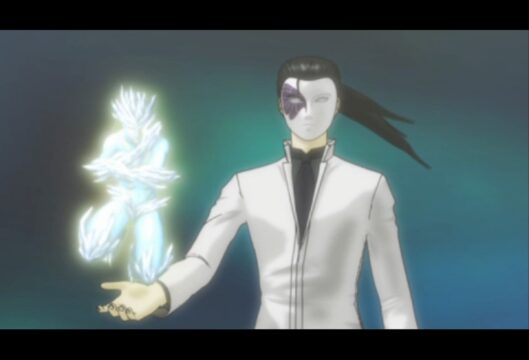
This mysterious man plays a major role in the story. His remake’s version is far more polished than his original PlayStation counterpart.
After the town becomes a dangerous place where demon sightings are commonplace, the plot can progress towards two different directions depending on the player’s actions: the SEBEC Route or the Snow Queen Quest. The SEBEC Route adheres to a linear progression and requires more time to be cleared, whereas the Snow Queen Quest — absent from the US release of the original game — offers a degree of freedom that potentially results in a great yet rewarding challenge for those attempting to clear the dungeons in a different order than originally intended. Nonetheless, both storylines are of equal significance, given that in each scenario the fate of the world is at stake. While the regular demons encountered are the same in both storylines, the main antagonists are different as well as the relevance of certain characters and some of their themes. This makes for a good incentive to experience both plotlines, which offer various mysteries prompting the player to learn more, all the while explaining a few theories of Jungian psychology so dear to the Persona series.
Fighting demons makes up a great part of Shin Megami Tensei: Persona and happens randomly whenever players navigate the overworld or explore a dungeon via first-person perspective. Once a fight starts, the screen transitions to a grid-based area split in half: the first part occupied by the player’s party and the second by the enemies. Battles unfold in a turn-based fashion, with the player selecting the actions of all party members before both sides trade blows. The protagonist and his friends are capable of using melee weapons, firearms, or the skills of their Personas. Whatever the offensive option used, it has a determined range, which warrants careful positioning considering not only their skills but also the opponents’ attack range. A well-thought-out formation can prevent many characters from being affected by the same attack or keep a few teammates out of reach of certain melee skills.
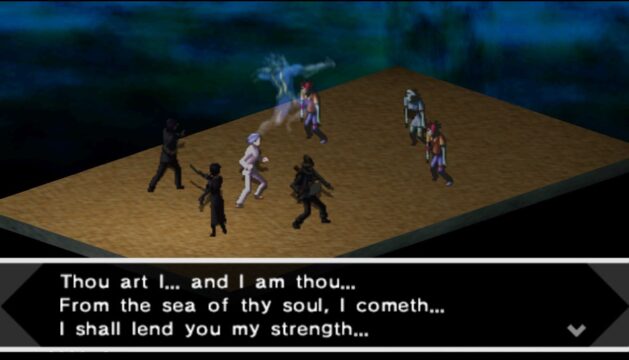
The Personas are the main cast’s best asset to fight against demons, which include zombies and supernatural creatures from various mythologies.
As a spin-off of Shin Megami Tensei, the game has inherited many of its aspects such as an affinity system. Each ally or foe has a set of affinities that determine which types of attacks they are weak or strong against. Thus, a target sustains more damage from certain kinds of offensive skills, while suffering less harm from others. Some demons and Personas are even immune to certain elements, capable of regaining hit points after being hit by spells with a specific attribute or redirecting the skill cast on them back to the caster. This incites players to target the enemy’s weakness as much as possible and ensure the foes don’t take advantage of the same mechanic. While simple in principle, the task can prove difficult in case one hasn’t figured out how the enemies’ type and subtype relate to their affinity. Surprisingly, there isn’t any explanation in the game about this matter and the status screen of an enemy provides only partial information about its affinities at best. This sort of situation calls for either experimentation or making use of outside resources. Those electing to experiment will find themselves very limited in this endeavor, considering there are 28 types of attacks and barely a few of these types are at the party disposal at a given time. Element and force skills are an early enigma for newcomers that is never explained by the game, but once players have figured out their meaning and the type-subtype-affinity relationship, determining a foe’s strengths and weaknesses becomes child’s play.
Another feature Shin Megami Tensei: Persona takes from the Shin Megami Tensei series is the demon negotiation. As implied, demon negotiation involves initiating a conversation with a demon by using different actions such as singing, praising, scolding, and more. Depending on the demon’s personality, the action performed raises its feeling of anger, eagerness, happiness, or scariness. An angry enemy is prone to strike the party by surprise, while an eager opponent gladly grants one of the player’s demands. Managing to instill different feelings at the same time in a demon may result in the latter suffering from a status ailment or prompt it to retreat from battle. These possibilities make demon negotiation an effective tool to gain the upper hand during battle or avoid fighting altogether. However, things don’t always go smoothly even for those blessed with a good knowledge about demon personalities, as these creatures also make requests from time to time. Not satisfying these requests is generally the best way to anger the demonic interlocutor. Yet, gaining access to different Personas isn’t possible without the demons’ Spell Cards only obtainable through negotiation.
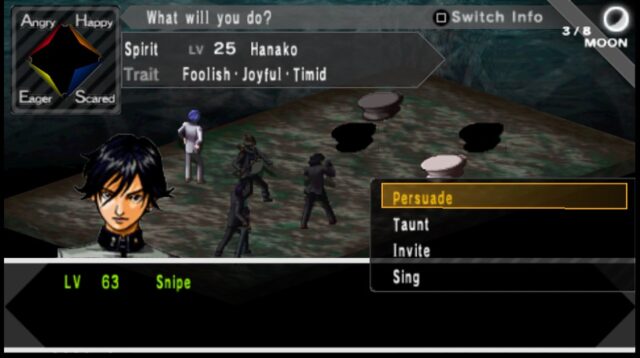
Well-handled negotiations with demons come with many benefits such as Spell Cards, which are required to create new Personas.
The titular Personas are not only central to the story, but also an important part of gameplay. While Personas are said to be the manifestation of their summoner’s selves, they are also figures from various mythologies such as Odin, Hanuman, Oberon, and more. A character has access to up to three Personas, with only one being equipped at any time. The equipped Persona grants bonus stats to its wielder, changes its user’s affinities, and allows to perform any skills it previously learned. Igor, Master of the Velvet Room, offers various services related to Personas: their fusion or creation, their storage, and their deletion. A lot can be accomplished through the fusion process, such as increasing Persona stats, learning additional skills, or granting passive abilities, though it’s up to the player to find them.
There is not much to do in Shin Megami Tensei: Persona other than advancing the story. Dungeons are explored one after another, the main obstacle to the player’s progression being the great number of random encounters. Although in-game methods exist to temporarily lessen or pause it, the high encounter rate proves particularly upsetting when the party ends up in a dead-end and just wishes to backtrack to the right path. The dungeons rarely have anything that encourages the player to explore them and don’t come with many gimmicks to break the monotony. Rare rooms scattered in the dungeons have treasure chests and opportunities to interact with party members. Those interested in these special interactions between party members will be forced to replay the game multiple times, considering that swapping teammates isn’t possible past a certain point of the story.
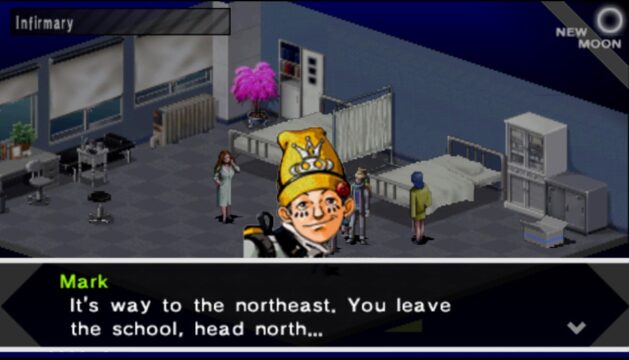
Whenever players don’t know what to do or where to go, they can talk to their teammates for potential insights. This is also a good way to learn more about the different party members.
All of the visuals — the characters, the demons, the backgrounds, etc. — are more polished in the PSP remake than the initial PlayStation release, with many animated cinematics added or reworked. One of the greatest beneficiaries of this cosmetic improvement is the town of Mikage-cho serving as overworld, whose environments are more accurately rendered. The graphics and cinematics of the remake aren’t the best the PlayStation Portable has to offer. However, the little details of the character models, the battle animations, the voices of the fighters upon attacking or receiving damage, and the sound effects provide an immersive experience. When exploring dungeons, the first-person perspective is elaborate enough that one can easily forget the movement is grid-based.
Besides the polished visuals of the PSP remake, another thing is apparent to anyone familiar with the US PlayStation release: the changes pertaining to the localization. The US version of the original game saw it converted to an American setting with the Japanese names replaced by ones more common in the West. For the PSP remake, the Japanese names are retained. This helps the game fit within the series’ subsequent entries, some of which call back to it.
The game’s soundtrack is its strongest point. The music perfectly matches the ambience of the locations visited, and it changes when needed to fittingly suit the tone of any story development. The battle themes deserve a special mention: Lone Prayer, played during fights against regular enemies, makes the high random encounter rate something almost enjoyable, while Bloody Destiny turns boss fights into a pleasure one wants to enjoy as long as possible.
While Shin Megami Tensei: Persona outclasses the original Revelations: Persona, it undeniably is surpassed by its sequels in many aspects, and the lack of proper tutorials or explanations about the game mechanics doesn’t help its case. Many players accustomed to the quality-of-life improvements and tutorials implemented in the recent Persona titles will likely get turned off before being able to grasp the subtleties of the game’s battle system and other aspects of the gameplay. Nonetheless, for those who are able to get stuck into it, Shin Megami Tensei: Persona remains a satisfying and engaging RPG.


Interesting battle system and game mechanics
Snow Queen Quest storyline that was absent from the US PlayStation release
Optional and rewarding challenge
Excellent soundtrack
Lack of specifics about key game mechanics
Not enough opportunities to learn about the main cast
Dungeons don't encourage exploration
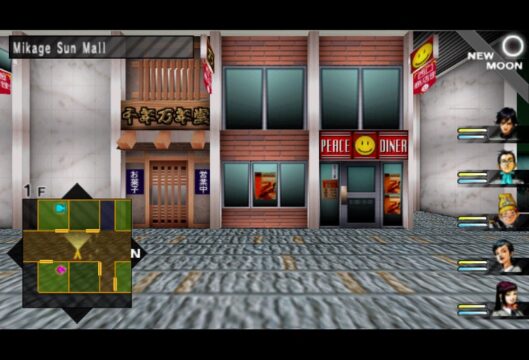






Recent Comments